by Rick Landers
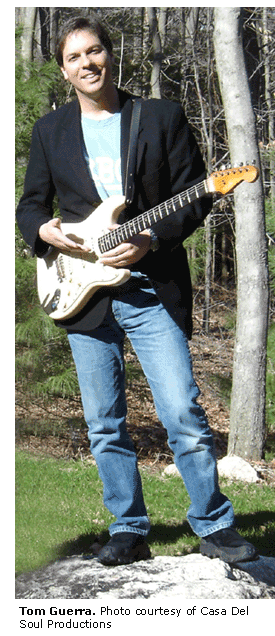 Reeling in the years, Tom Guerra keeps his guitar locked into vibes of the ’60s and ’70s. With his small arsenal of vintage guitars on hand to anchor the sound to classic rock sounds, Tom cues up riffs reminiscent of those days when hair was shoulder length, garage bands could nail #1 hits, and kids showed up at parties with bottles of Ripple wine for a good buzz.
Reeling in the years, Tom Guerra keeps his guitar locked into vibes of the ’60s and ’70s. With his small arsenal of vintage guitars on hand to anchor the sound to classic rock sounds, Tom cues up riffs reminiscent of those days when hair was shoulder length, garage bands could nail #1 hits, and kids showed up at parties with bottles of Ripple wine for a good buzz.
Tom and his band mates Scott Lawson (vocals), Mike Hayden (drums), Kenny Aaronson formed Mambo Sons, but not before Tom turned out his first solo CD, Mambo Sons, featuring co-lead guitarist and rock icon Rick Derringer.
Guerra issued his second release, Play Some Rock ‘n Roll! to high acclaim with New York Rock magazine calling it one of the best independent releases of 2002.
Tom’s writing talents extend beyond music lyrics and his writing and interviews have been published in both Vintage Guitar and Guitar International magazines. Tom maintains a journal at Guitar International magazine to keep his fans and fellow guitar lovers informed of the hard work and dedication necessary to be a working musician with the ambition to seek higher musical ground.
Along with his guitar work with Derringer, Tom Guerra has performed with Max Weinberg, Charles Calmese, Jaimoe of the Allman Brothers, the Dirty Bones Band and the Delrays.
The Mambo Sons released their latest CD in August 2005 entitled Racket of Three. The album has been named Album of the Year by Thailand’s Pattaya Mail, the country’s first English language newspaper. And the band graciously offered all proceeds of the CD’s September 2005 sales to support flood victims in the New Orleans area.
Along with Tom on lead guitar, the Mambo Sons lineup now includes Scott Lawson (bass and vocals) and a new drummer, Joe “The Cat” Lemieux. The Sons have an extended family of guest musicians that include: Matt Zeiner (Hammond B3 and piano), Mike Hayden (drums), Jeff Keithline (bass), Kenny Aaronson (bass), Collin Tilton and Doug Jones (saxophone), Rick Derringer (guitar), and Alan St. John (piano).
The Mambo Sons sound is driven by the school of classic rock with some contributions from Rick Derringer. How did that collaboration come about
Tom Guerra: Rick played on our first album. I met him when I was out promoting a blues album I had recorded with my old group The Delrays. that also featured Joe “The Cat” Lemieux, Mambo Sons’ drummer.
I was on a radio show, and he called in anonymously saying he liked the guitar work on the record, and on the air, I asked him if he played. He sort of laughed and said, “Sure do,” and and when he told me his name I almost dropped. We talked and hung out several times and I mentioned to him I was going to be doing a solo record, which became the first Mambo Sons record, and he said he’d enjoy sitting in.
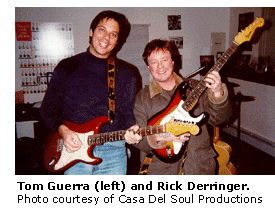
He contributed some great guitar work to that record – just played his relic Strat tuned down a full step, straight into my ’66 blackface Fender Vibrolux Reverb.
There seems to be a lot of vintage gear hanging around the recording studio during production time. Looks like you’re trying to create and craft your music straight from the era that drove a lot of kids out of the house and into garages to start their own bands.
TG: That’s no accident. We’ve always been fabs of vintage gear, and over the years we’ve equipped our studio, Casa Del Soul, with some great original gear including tweed and blackface Fenders, old Marshalls, a ’65 AC30 TB, and some Ampegs, and guitars ranging from ’50s and ’60s Strats to Les Pauls. These things were just stuff I came across and picked up all over the U.S.
Did you grow up in a house full of rock ‘n’ roll?

TG: I was extremely fortunate to have a mom who was always into jazz and blues, and a dad who grew up liking Chuck Berry, Bo Diddley, and eventually The Beatles, Stones and Dylan. Some of my earliest memories are sitting with my dad looking at the Sgt. Pepper’s cover. I was only 4 or 5 at the time, but was captured by the sound.
What inspired you to pick up your first guitar?
TG: Well, my older brother Paul played for about six months until he discovered girls [Laughs]. But what really got me started was that my mom had an old Silvertone acoustic which she bought out of the Sears catalog, with a great neck.
Well one day, the neck mysteriously fell off! This happened to coincide with the creation of a Flying V body that I had built in wood shop in 8th grade. I fastened that neck and body with a big metal plate, bought 2 used Gibson mini-humbuckers, figured how to wire it up, and made a bridge out of a solid bar of brass – great intonation! [Laughs]
From there, I ran it into the input jack on an old stereo I had, and it sounded absolutely honkin’! After modifying that to the point of ruin, I built a second guitar using these same parts but with a Leo Quan Badass bridge so I could fix it so the intonation, would not offend your ear, to quote Frank Zappa.
Then, one day, a friend my age was over at my house. I had just met this kid, his name was Wayne Arute, whose family is huge on the NASCAR circuit, and he said to me, “I like the way you’re playing that guitar. I have an old Gibson SG, would you like it?”
He actually gave me his ’68 SG Special with P90s, and I’ve been indebted to him ever since. Thanks, Wayne! From there, my brother and I bought an Ampeg VT40, still one of my all-time favorite growlers. Our neighbors hated us!
You’re a Strat guy?
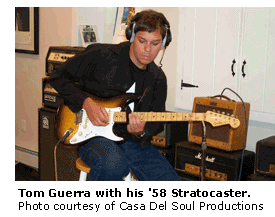
TG: Since that initial SG, I’ve always loved the sound of single coils. I became a big fan of Rory Gallagher in the late ’70s and since the early ’80s, I’ve pretty much played Strats exclusively live.
I have been lucky enough over the years to own many great pre-CBS strats and really love them all. They are all unique in their own ways. For whatever reason, I feel when I am playing a Strat I am most comfortable, in terms of being able to voice what I am thinking.
That being said, a lot of the studio stuff I’ve done over the years has been with Gibsons. My old goldtop with P90s is a perennial favorite! I recorded some Freddy King covers like “The Sad Night Owl” and “Remington Ride” years ago, and an original called “You’re All The Same” and it just nailed that early Freddy King in-between-the-pickups tone. Live, however, I like the weight and feel and layout of Strats, plus I think they stay in tune better.
A few years back, I was approached by Brian Moore Custom Guitars to represent their company as an endorsement artist, and they designed a dual cutaway guitar, with 3 P90’s. I asked them to wire it like a modern Strat with a 5 -way, and hum canceling in the 2nd and 4th positions. Over the years I have owned hundreds of guitars, yet this guitar is probably in my all time top 5. Because of the tonal variations and hum canceling, it gets a lot of use both live and in the studio.
On Mambo Sons second outing you cross over several classic rock borders, as well as land on some firm Warren Haynes ground with “Blame It All On You”. Did you grow up learning all the rock riffs you could spin on the turntable?
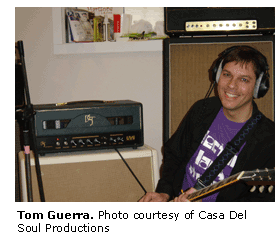
TG: A little secret about “Blame It All On You”. That’s the exact riff of “Tomonga Street” (off the first MS album) played backwards. Kenny Aaronson, our bassist on the first album, told me his favorite track off that record was “Tomonga Street”, and sort of jokingly said that I should write a whole album’s worth of riffs like that, in that open G tuning. So one day, just messing around, I played that riff backwards and it became “Blame It All On You”.
But to answer your question, I have never been good at figuring out riffs from record. I never wanted to do that. I always preferred to figure out why my favorite guitarists played the notes they’d play, versus how they did that. I figured if I could understand the logic behind it, the technique could follow. Of course I’m still waiting for it![Laughs]
Tell us about the groups latest CD, Racket of Three and how the group has changed since the Mambo Sons’ debut CD.
TG: Racket of Three was originally intended to be an acoustic album, but one day our singer, who’s my songwriting partner, Scott Lawson found an old tape of riffs and musical ideas that I had sent him the prior year.
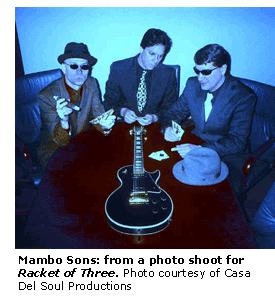
He said we’ve got to use this stuff and he came up with lyrics for the music. It is by far the best thing I have ever been involved with and most diverse in terms of tones and colors.
Its called Racket of Three because we are now a trio, with Scott assuming bass duties as well as lead vocals, plus we make a helluva racket. I love the trio thing live! It lets us use space to our advantage, and never gets too cluttered sounding.
How did you meet the other guys and what made the band click?
TG: Scott and I have been close friends since our freshman year of college. He was walking through the courtyard one day on campus, and simply followed the music he heard. I was playing Free’s “I’m a Mover” on my Les Paul Junior through an Ampeg V4 stack, at full volume, considerate person that I was. I had my door open, and when I took a break, he popped his head in the door sideways and said, “I know that tune!”
Over the years we both had our own groups, but we’d frequently sit in with each other and write together. I knew if I was ever given the chance to do my own thing, that I wanted Scott to sing and co-write and when I got a chance to make what became the first Mambo Sons CD, we already had about 15 songs to choose from.
It was going to be a solo thing but he had put so much of himself into it, it became about us. We have a great partnership. Typically, I send him some riffs or musical ideas, he’ll put some lyrics to the ones that move him, and we then get together to bash them into shape.

Joe and I played together in a few bands that were regulars on the regional club circuit, including the Producers and The Delrays. Joe guested on our first CD, and joined us full time around the time we started writing for Racket of Three.
The band clicks probably because we get along as people. We are very different people, but we all have a simpatico. From a musical perspective, we click because we like the music, and thereâ’s no redundancy. We all have to pull our own weight and do the best we can.
How’d you end up with Marshalls rather than using Twins or a classic Vox AC30? What were you looking for in the way of sound?
TG: The first Mambo Sons record was mostly my ’65 AC30 top boost, with the occasional Marshall and Ampeg thrown in. By the time we recorded Play Some Rock & Roll! , our second album, I was using the Marshall PA20 exclusively in the studio. Still one of my all time favorite amps. It is amazing!
They have long been a hidden secret, until last year when Marshall began reissuing them. The EL84s make them so toney. I tried using PA20’s live, but they are just not loud enough to keep up with a drummer.
So, then I started using Marshall 50s live and found the sound I was looking for. My main gigging amp is a 1970 smallbox 50, a number 1986 Bass Model. I love this amp. Several years ago in New Orleans, I was lucky enough to find this amp together with its twin brother, a model 1987.
Both were made on the same day in 1970 and they are only 5 serial numbers apart. And both were just covered in gunk and grime. I sent them up to Bob Dettore of DST-Engineering for cleanup and Bob was amazed at how filthy they were, but also how good they sounded. Bob and his partner Jeff Swanson do all of my amp and cabinet work and I’m currently endorsing their DST UV6, a great amp that also figures prominently on Racket of Three.
Tell us about the wall of guitars you have pictured on the Mambo Sons website.
TG: Those are all guitars that I have been fortunate enough to find and keep over the past 25 or so years. As you see, there are a lot of original Strats from the ’50s, ’60s and ’70s. And I actually like some of the ’70s Strats.
In the old days, when I wanted another guitar, I’d have to sell mine to buy it. After a foolish mistake I made, selling my ’68 maple cap Tele to fund a ’70s Strat that I wanted, I vowed that I would never sell a keeper again.
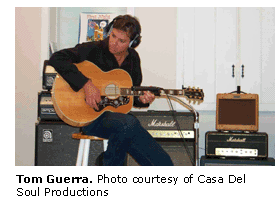
So, over the years, hundreds of pawn shops, tag sales and classified ads later, I have been able to hold onto some great guitars, all of which I play. And there’s no sentimentality either, if I find that I am not playing a guitar, it goes on the market so someone else can play it.
Just over the past year I have sold some great vintage pieces like a mint J-200, a beautiful reverse Firebird, a nice korina Gibson V, and an alpine white EDS-1275, because I wasn’t playing them. My Dad sort of put the whole thing in perspective one day when he was visiting the studio.
He said “Wow, lots of nice guitars! How many can you play at once?”
So the message is not the number of guitars to own, but the number of guitars to which you bond.
Any new additions on the way?
TG: I try not to buy just for the sake of buying, but to fulfill a sound either live or studio. That is unless I step right into something!
When we did our second cd Play Some Rock & Roll!, I was going for a Byrds/Beatles sound on several tunes that required a 12-string electric tone, so I grabbed a couple of white Gibson EDS-1275 doublenecks. Didn’t want a cherry one because of the Jimmy Page association, even though he’s an all time favorite of mine. But they are so heavy and cumbersome, they became sort of a drag to bring out live. These days when we do those tunes, I just play the 12-string parts on a 6-string.
I’m pretty much all set as far as tones that I am looking for, however, if I am recording something that needs a specific sound, I’ll try to run that down.
Got a dream guitar that you’d like to own?
TG: Of course everyone would love a ’58, ’59 or ’60 Les Paul.
I’ve never owned one of those, but have played a few, and they are magical guitars. I have a ’59 Reissue with Peter Florance Voodoos in it that’s a great lightweight guitar.
But there’s nothing like an original.
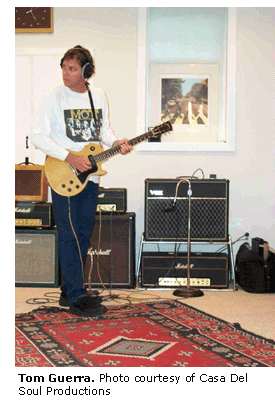
The only sort of guitar I ever pursued has been a LP TV Special. I played one in the ’70s that I absolutely fell in love with, but never found the right one until about 6 years ago. I found a well played but clean and original one from the original owner’s son. His dad had been a jazz musician, kept flatwounds on it, and I don’t think he ever had the tone or volume control ever fully turned up.
I also think he never cleaned it, as it was covered in little brown dots of what I thought was dirt. When I had Frank Lucchesi, owner of Lucchesi Vintage Instruments, go through that and clean it up, he told me that the dots were literally blood of the former owner! He must have literally played it so much that his fingers bled. Kind of like that movie The Red Violin.
Besides being a musician, it looks like you’ve got a bit of a writing career going as well.
TG: You gotta do what you can do, ya know, and I enjoy doing that. I’ve been writing for Vintage Guitar magazine for 8 years now and in that time have been fortunate to interview and learn from some of the greats.
One of my favorite pieces was the biography I did on Paul Kossoff, which is actually on Gibson Guitars’ website. I got to spend time with Sandhe, his partner and muse, who gave me such an insight into Koss, from his personality, love of music to his darker side.
One of the most poignant interviews I conducted was of Free bassist Andy Fraser, who after 15 years seclusion, granted Vintage Guitar magazine an exclusive interview on his career and recent announcement that he is living with AIDS.
I later went on to interview Simon Kirke and Rabbit Bundrick, so I guess the only member of Free that has eluded me is Paul Rodgers.
I also did an article for Guitar International, a review of the Cream Reunion Concert at Madison Square Garden. This article was picked up by Reuters, BBC and MSNBC, so that was nice exposure.
How’d you end up in the studio with The Animals’ Hilton Valentine?
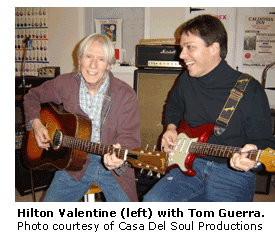
TG: I’ve always been a fan of Hilton’s, having covered many Animals’ tracks over the years. One sunny day in January, I invited Hilton and his very nice wife Germaine over to my studio to discuss his career and new album.
After a few Newcastles, we ended up jamming on some of Hilton’s excellent new music off his It’s Folk and Skiffle, Mate CD, as well as some of his classic tunes. He is a true gentleman and a great player!
Racket of Three was named Album of the Year in Thailand?
TG: We are obviously very happy with that! It was certainly a big honor, as they love rock and roll over there. Our last album Play Some Rock & Roll! was named as a top indie pick in 2003 by NYRock magazine, and that also helped open some doors. But really, any positive press is good as it’s such an uphill battle trying to get your own music heard. With the advent of the internet, people all over the globe can search out our music, which I think is accessible for any fans of guitar based rock and roll.
Any plans for the Mambo Sons to head out on tour soon?
TG: We have some dates lined up for late Spring in New York and Connecticut, and hope to do more throughout New England throughout the summer.
To date, you’ve released three CDs with Mambo Sons. Any more on the way or maybe a DVD?
TG: Every live show we do, people come up to us and ask us when we are recording a live album, in some instances saying they prefer our live versions to the studio recordings. I like playing both live and in the studio, but they are such different animals. Studio is a chance to be creative and inventive and multi-dimensional; live, especially with a trio, you just have to rely on more energy, brute force and ignorance.
I’ve heard some live board tapes of us, and some have such a ferocity that we haven’t yet captured in the studio, except for maybe “Been Outta Touch” or “Sidewinder Walk” off of Racket. So I think that a live CD or DVD is in our future, maybe our next project!
Related Links
Mambo Sons
Tom Guerra’s Journal on Guitar International